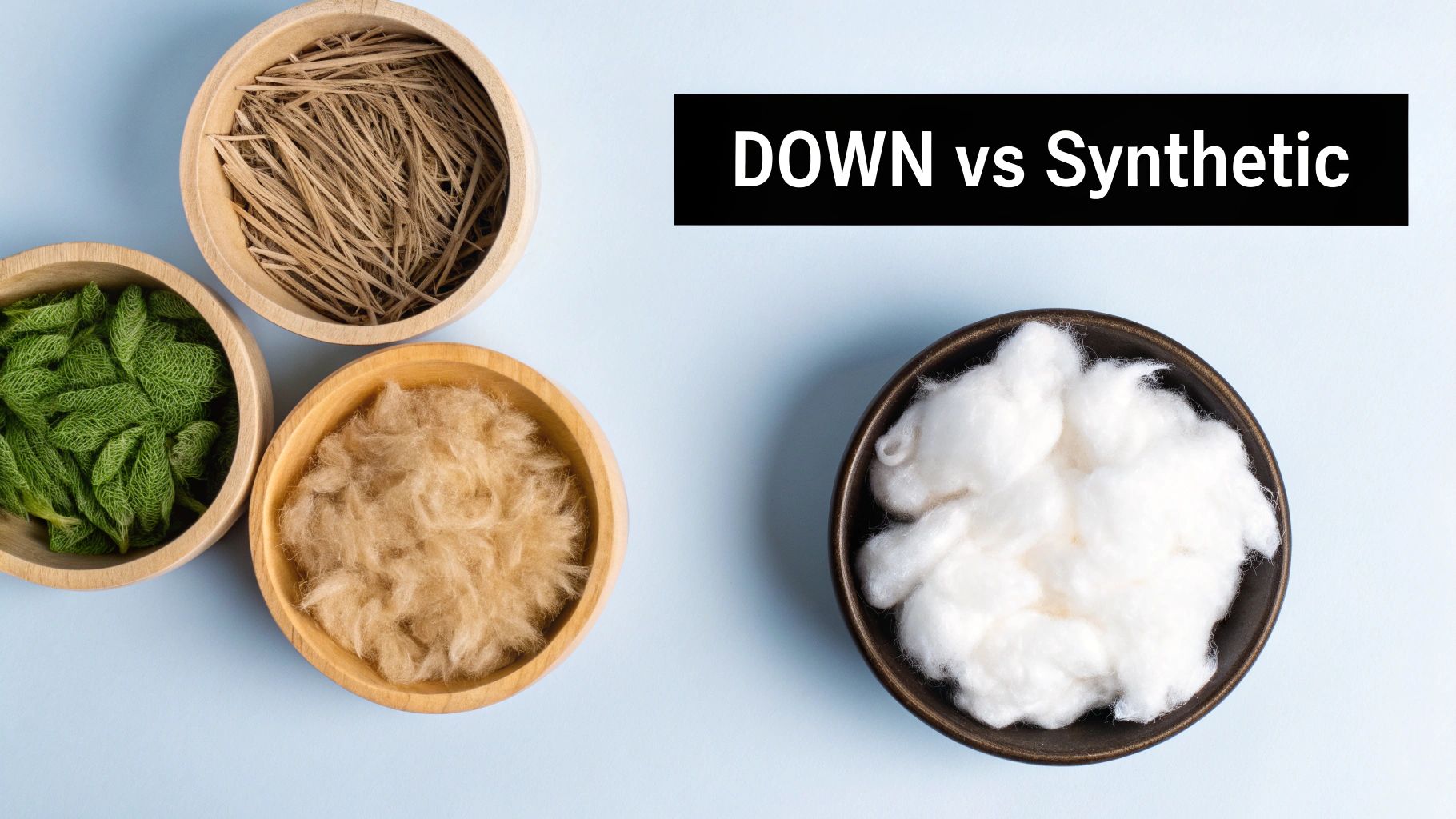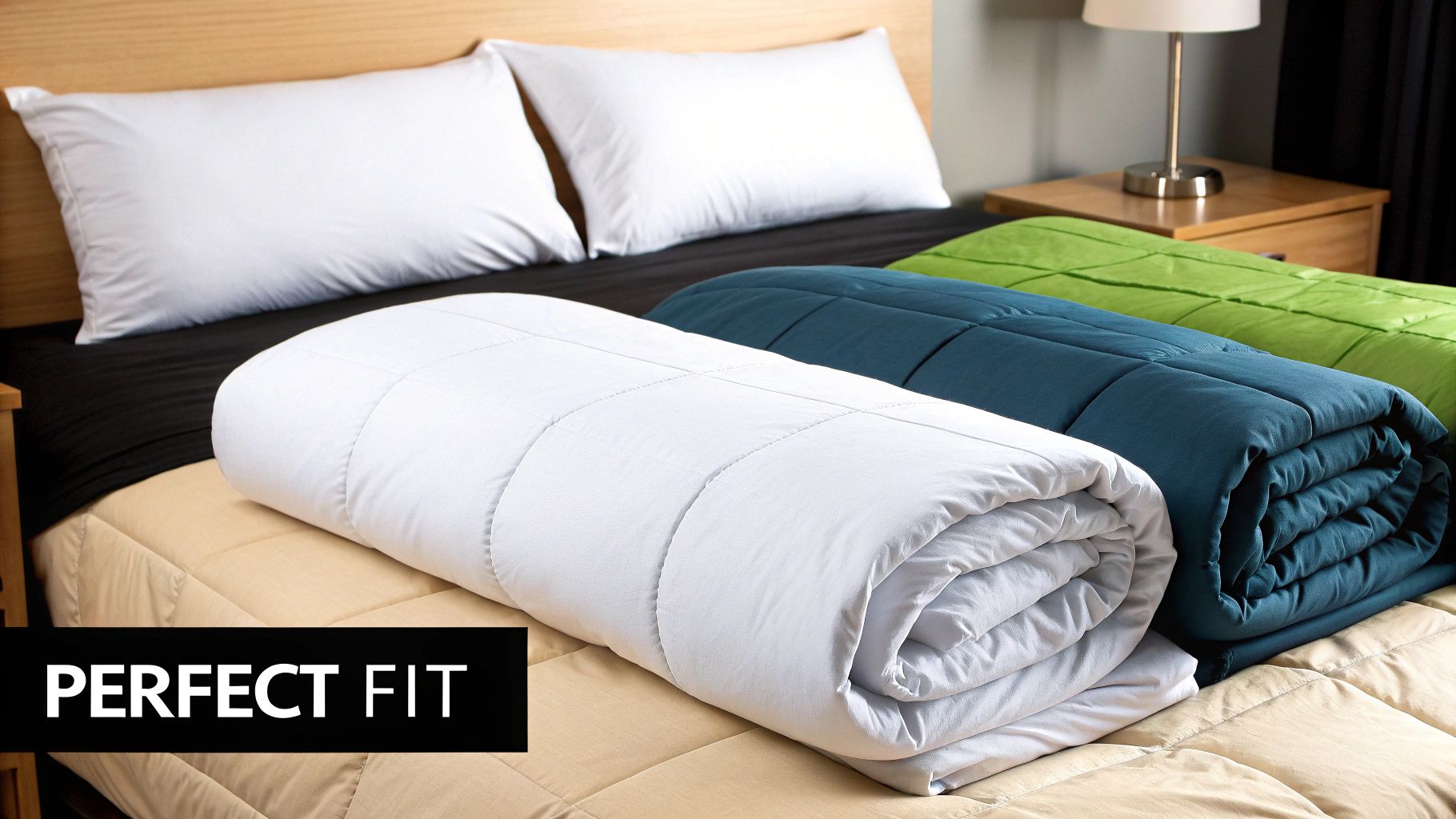Walking into a bedding department can feel a little overwhelming with all the choices available. So, what exactly is a duvet? In simple terms, it is a soft, flat bag filled with insulating material like down, feathers, or a synthetic alternative. It is designed to be slipped inside a protective, removable cover, which then acts as the cosy top layer of your bed.
What Makes a Duvet Different

Choosing new bedding can feel like a big decision, but it all becomes much clearer once you know the basics. A duvet is a two part system, you have the inner duvet which is the filled part, and the outer duvet cover which works like a giant pillowcase. This simple but clever combination is what makes it different from a traditional quilt or comforter.
The real benefit of the duvet is its practicality. Instead of trying to wash a bulky comforter, you just take off the cover and pop it in the machine with your sheets. This makes laundry day so much easier and helps keep your bed feeling fresh and clean.
Simplicity and Style in One
One of the best things about a duvet is how easily you can change the look of your bedroom. A new duvet cover can completely transform the style and feel of your room in minutes, saving you the cost of buying a whole new bedding set. It is this brilliant flexibility that has made them so popular.
This move towards stylish, comfortable bedding is happening all over the country. The UK bed linen market, valued at USD 1.82 billion, is expected to almost double by 2035 as more of us look to create a restful sanctuary at home.
The two part design makes bed making much simpler, too. A quick shake and a smooth out are all it takes to get that clean, inviting look. For a deeper dive, take a look at our guide on what duvets and covers are.
A duvet offers a wonderfully straightforward approach to bedding. It combines practical warmth with endless style possibilities, making it the foundation for a comfortable and beautiful bed.
With a duvet, you can also adapt to the seasons without any fuss. Simply swap your lightweight summer insert for a warmer one when winter arrives, all while keeping the decorative cover you love. This smart, practical approach ensures you stay perfectly comfortable all year round, snuggled under a single, cosy layer.
Decoding Tog Ratings for Year Round Comfort

When you start shopping for a new duvet, you will see the word 'tog' everywhere. It is a term you only really hear in the world of bedding, but what it means is very straightforward. Put simply, a tog rating is a measure of how well a duvet insulates, or how good it is at trapping warm air.
It is a common myth that a higher tog means a heavier duvet. A high quality down duvet, for example, can feel almost weightless yet have a very high tog rating because down is fantastic at trapping heat. So, remember it is all about warmth, not weight.
Getting the tog rating right is key to keeping your body at a stable, comfortable temperature all night. It helps you avoid waking up too hot or shivering with cold, letting you sink into a deep, restful sleep. It is about creating that ‘just right’ feeling, season after season.
Finding Your Perfect Tog
Choosing the right tog rating comes down to a few personal factors. Think about how warm or cool your bedroom usually is, whether you tend to sleep warm or feel the cold, and of course, the time of year.
To help you decide, here is a quick look at what the numbers mean.
Your Guide to Duvet Tog Ratings
The tog rating system makes it easy to find a duvet that suits your needs. From a light covering for summer to a deep, cosy wrap for winter, there is a tog for every season and every sleeper. This table breaks down the most common ratings to help you make the perfect choice.
| Tog Rating | Best Season for Use | Description of Warmth |
|---|---|---|
| 2.5 to 4.5 tog | Summer | Very lightweight and breathable. Perfect for hot nights or if you naturally sleep warm. |
| 7.0 to 10.5 tog | Spring and Autumn | A great middle ground for changeable weather. The 10.5 tog is a UK favourite. |
| 12.0 to 15.0 tog | Winter | Designed for maximum insulation to keep you snug and warm on the coldest nights. |
Ultimately, the goal is to match your duvet to your environment and personal comfort. A well chosen tog rating can genuinely improve your sleep by helping your body stay at its ideal temperature without any effort.
The Brilliant "All Seasons" Duvet
If you are looking for real versatility, an all seasons duvet is a fantastic solution. This is not one duvet, but a clever combination of two. Typically, you get a lightweight 4.5 tog for summer and a warmer 9.0 tog for spring and autumn.
You can use each one on its own, or for the coldest nights, simply fasten them together. This creates a wonderfully cosy 13.5 tog duvet that is perfect for the depths of winter. It is a practical approach that gives you three duvets in one, ensuring you are ready for whatever the unpredictable British weather has in store.
Finding the Right Duvet Filling for You
The filling is what gives a duvet its character. It determines everything from how warm it keeps you on a chilly night to how it drapes over you. Think of it as the engine driving your comfort, and choosing the right one really comes down to your personal preferences, budget, and whether you have allergies.
Let's look at the main types. Understanding the difference between natural and synthetic fillings will make it so much easier to find the duvet you will love sleeping under for years to come. Each one offers a different feel, suited to different kinds of sleepers.
Just looking at a well made bed can make you feel cosy, and the right duvet is essential for creating that sanctuary like feel in your bedroom.

It is all about capturing that perfect sense of comfort and turning your bed into a place you genuinely cannot wait to retreat to.
Natural Duvet Fillings
Often seen as the gold standard, natural fillings are known for luxury for a good reason. They are incredibly lightweight yet exceptionally good at regulating temperature. That means they keep you warm when it is cold and, just as importantly, help you stay cool when it is warmer.
- Goose or Duck Down: This is the soft, fluffy insulation found underneath the tougher feathers of birds. A duvet filled with down feels almost weightless, like being tucked in under a warm cloud. Goose down clusters are generally larger than duck down, allowing them to trap more air and offer better warmth with less weight.
- Feather and Down Mix: Blending feathers with down creates a duvet that has a bit more substance and weight to it. This combination finds a great balance between plush comfort and affordability, giving you that satisfying, ‘tucked in’ feeling that many people love.
The real magic of natural fillings lies in their breathability. They allow moisture to escape throughout the night, which stops you from feeling clammy and helps you stay at a steady, comfortable sleeping temperature.
Synthetic Duvet Fillings
Modern synthetic fillings are a brilliant choice, particularly if you have allergies or are looking for a more budget friendly option. These materials are designed to copy the insulating qualities of natural down and are wonderfully easy to look after.
- Hollowfibre: As the name suggests, this filling is made from strands with a hollow centre. This clever design is fantastic at trapping air, which is what provides the warmth. A hollowfibre duvet feels springy and full, and it holds its shape well, which makes it a durable, practical choice for the whole family.
- Microfibre: Made from extremely fine fibres, microfibre feels incredibly soft and silky to the touch, coming very close to the luxurious feel of pure down. It drapes beautifully and is a superb option for anyone wanting that premium experience without the premium price tag.
It is clear that people are investing more in their sleep. The UK luxury bedding market, which includes high end duvets, is projected to grow from USD 98.5 million in 2025 to roughly USD 135 million by 2032. This shows a growing appreciation for quality materials and better comfort in our bedrooms. You can learn more about the growth in luxury bedding and the trends driving it.
To make the choice a little clearer, here is a straightforward comparison between natural and synthetic options.
Natural vs Synthetic Duvet Fillings
| Feature | Natural Fillings (Down/Feather) | Synthetic Fillings (Microfibre/Hollowfibre) |
|---|---|---|
| Feel & Comfort | Exceptionally soft, light, and breathable. Drapes closely to the body. | Can feel soft and down like (microfibre) or full and springy (hollowfibre). |
| Insulation | Superior warmth to weight ratio. Excellent temperature regulation. | Very effective insulation, but can be less breathable than natural fills. |
| Allergies | Can sometimes trigger allergies, though high quality casings help. | Hypoallergenic and ideal for sensitive sleepers or those with asthma. |
| Care | Often requires professional cleaning. Can be trickier to wash and dry at home. | Typically machine washable and easy to care for, drying relatively quickly. |
| Durability | Very long lasting if cared for properly, retaining its loft for years. | Durability can vary, and may flatten or clump over time with repeated washing. |
| Cost | Generally more expensive, and considered a long term investment. | More budget friendly and accessible, offering great value for money. |
Ultimately, whether you lean towards the timeless luxury of down or the practical comfort of synthetics, you are investing in better sleep.
Eco Friendly and Speciality Fillings
If you are looking for something a bit different or more sustainable, there are some fantastic alternatives out there.
- Wool: An incredible natural insulator, wool is also highly breathable and brilliant at wicking away moisture. It is a game changer for people who tend to overheat at night, as it actively helps regulate your body temperature.
- Silk: Filled with long, delicate strands of silk, these duvets are naturally hypoallergenic and surprisingly lightweight. They drape elegantly around you, providing a gentle and consistent warmth.
In the end, choosing a duvet filling is a very personal decision. It is all about what feels right for you. Whether you fall for the weightless warmth of down or the easy care comfort of microfibre, finding the right match will completely transform the way you sleep.
Matching Your Duvet to Your Bed Size
You have picked the perfect filling and the ideal tog rating, but the job is not done yet. Getting the duvet size right is just as important for how your bed looks and, more importantly, how well you sleep.
A duvet that is too small often leads to a nightly tug of war for cover. On the other hand, one that is far too big can feel heavy and end up pooling on the floor. The sweet spot is a duvet that drapes generously over the mattress, giving you that inviting, plush look while keeping you perfectly cosy all night.
A Simple Guide to UK Duvet Sizes
Thankfully, UK duvet sizes are standardised to match our mattresses, which makes choosing the right one pretty straightforward. Still, it is always wise to double check the specific dimensions in centimetres before you buy, as they can vary a little from one brand to another.
Here is a quick rundown of what you will find.
- Single: Measuring 135cm x 200cm, this is the go to for single beds, bunk beds, and smaller guest rooms.
- Double: The most popular choice in the UK, a standard double is 200cm x 200cm. It is made for a double bed and works well for solo sleepers or couples.
- King: At 230cm x 220cm, this size offers more luxurious coverage for a standard king size mattress.
- Super King: The largest of the lot, a super king duvet is 260cm x 220cm, providing ample, opulent cover for the biggest beds.
Think of your duvet as the final layer that pulls the whole bed together. The right size does not just keep you warm, it gives your bed that polished, well dressed finish.
A Tip for a Better Night's Sleep
If you are tired of fighting for your share of the duvet, I have got a simple trick for you, go one size up.
Putting a king size duvet on a double bed, for example, gives both people plenty of coverage. This little hack means no one gets left in the cold, ending those middle of the night battles for good. It also happens to create that wonderfully full, oversized look you see in high end hotels and magazines.
For a deeper dive into dimensions, our comprehensive comforter size guide has even more helpful advice. It is a small detail, but getting the size right pays off massively in both comfort and style.
How to Care for Your Duvet
A quality duvet is a real investment in your sleep, and with a little bit of care, you can keep it feeling fresh, lofty, and comfortable for years to come. Looking after it properly is simpler than it sounds and mainly comes down to two things, protecting it and cleaning it the right way.
The single best thing you can do is use a good duvet cover. It acts as a protective shield against daily grime, body oils, and accidental spills. Just pop the cover in the wash weekly with your other bedding, and you have already won half the battle.
It is also a great idea to let your duvet breathe. When you get up in the morning, rather than making the bed straight away, fold the duvet back for an hour or so. This simple habit allows any moisture from the night to evaporate, keeping the filling fresh and preventing that stuffy, stale feeling.
Washing Your Duvet Properly
Even with a cover, you will want to give the duvet itself a proper wash every so often, maybe once or twice a year. Before you do anything, though, always check the care label. The manufacturer's instructions are your best guide, as the right method depends entirely on what the duvet is filled with.
Most synthetic duvets can be washed at home, provided your washing machine is big enough. You do not want to cram it in.
- Go easy on the detergent. A small amount of a gentle, liquid detergent is plenty. Too much soap is hard to rinse out and can leave a residue.
- Keep it cool. A gentle cycle at a low temperature is usually the safest bet for both the filling and the fabric.
- Add an extra rinse. It is worth running an extra rinse cycle to make absolutely sure all the suds are gone.
Duvets with natural fillings like down or feathers can be a bit more high maintenance. Some can be washed at home, but they often benefit from a trip to a launderette with industrial sized machines. This ensures they get a thorough clean and, crucially, are dried completely.
A thoroughly dried duvet is non negotiable. Any leftover dampness can lead to mildew and horrible clumping, ruining the filling. Patience is key here.
Storing Your Duvet
When you are ready to switch your cosy winter duvet for a lighter summer one, storing it correctly makes all the difference. First, make sure it is completely clean and bone dry.
Pack it away in a breathable storage bag, cotton works perfectly. Steer clear of plastic bags, as they trap moisture and can cause musty smells. A dry spot at the top of a wardrobe or in an airing cupboard is ideal for keeping it safe from dust until the colder nights draw in again.
For more detailed instructions, you might find our Snuggle Comforter care guide helpful.
Finding and Buying Your Perfect Duvet
Now that you have a clear idea of the tog rating, filling, and size you are after, it is time for the final and most exciting step, choosing where to buy your new duvet. You have got plenty of options, from sprawling high street department stores to specialised online boutiques, and each offers a very different shopping experience.
Visiting a physical shop has one major advantage you simply cannot get online, the chance to touch and feel the products. Big retailers like John Lewis or Dunelm usually have a fantastic range of duvets on display. This gives you a brilliant opportunity to compare the surprising lightness of a down duvet against the reassuring springiness of a hollowfibre one, helping you make a much more hands on decision.
Exploring Your Options: Online vs In Store
On the other hand, shopping online opens up a whole world of choice right from your sofa. The UK bed and bath linen market is actually the largest in Europe, and its huge digital footprint makes finding the perfect duvet easier than ever. This e commerce boom gives you access to niche brands, sustainable options, and often, more competitive prices. You can learn more about how online shopping is shaping the UK duvet market on datainsightsmarket.com.
Whether you are browsing in person or scrolling online, a little attention to detail will help you buy with total confidence.
- Read Customer Reviews: Honest feedback from people who are already sleeping under the duvet is gold. Look for comments on how it washes, its long term durability, and whether it really lives up to its warmth rating.
- Check the Return Policy: This is non negotiable, especially when buying online. A good return policy gives you peace of mind, allowing you to send it back if it does not feel quite right once you have got it home.
Your perfect duvet is out there, but do not rush the final decision. Taking a few minutes to read reviews and understand the returns process are small steps that make all the difference to your long term happiness.
Making a Conscious Choice
Finally, it is worth thinking about the values of the brand you are buying from. There is a wonderful and growing movement towards ethically and sustainably made bedding. Many companies now prioritise eco friendly materials, like recycled fillings or organic cotton casings, and are completely transparent about how their products are made.
Choosing one of these brands means you can sleep even better, knowing your comfort has not come at a cost to the planet.
Frequently Asked Questions About Duvets
Let us tackle a few of the most common questions that pop up when you are on the hunt for the perfect duvet. Think of this as a quick chat to clear up any final thoughts before you commit to years of blissful sleep.
Can I Use a Duvet Without a Cover?
While you could, I would strongly advise against it. A duvet cover is your duvet's best friend. It acts as a protective shield against sweat, oils, and dust mites, keeping the duvet itself fresh and clean. Washing a cover is a breeze, but laundering an entire duvet is a whole other story.
Besides, a cover is a fantastic way to switch up your bedroom's style. It is the simplest, most affordable way to give your space a completely new feel without having to buy all new bedding.
How Often Should I Replace My Duvet?
Even a top quality duvet will not last forever. As a general rule of thumb, most sleep experts recommend looking for a replacement every five years. Over time, the filling naturally compacts and loses some of its insulating power and delightful fluffiness.
You will know it is time when your once puffy duvet looks a bit sad and flat, feels lumpy in places, or simply does not keep you as warm as it used to. Of course, giving it a regular airing and following the care instructions will help you get the most out of it.
A great duvet is an investment in your wellbeing. Replacing it when it is past its best ensures you continue to get the comfortable, restorative sleep you deserve.
What Is a Baffle Box Duvet Construction?
If you see the term "baffle box" on a duvet's label, it is a sign of quality, particularly for duvets with natural fills like down or feather. It is a superior construction method where small fabric walls, or baffles, are sewn between the top and bottom layers of the casing.
This creates a grid of three dimensional boxes that hold the filling perfectly in place. The result is no more clumps or cold spots. It ensures you get consistent warmth from head to toe and helps the filling stay lofty and airy for much longer.
Are Expensive Duvets Actually Better?
In many cases, yes. While a hefty price tag is not the only thing that matters, it often points to higher grade materials and more thoughtful construction. Pricier duvets typically feature premium fillings, like high quality Hungarian goose down, which offers incredible warmth for surprisingly little weight.
They also tend to have superior casings made from high thread count cotton, which feels softer against the skin and is built to last. It is best to see it as a long term investment in your comfort. A well made duvet will not just feel more luxurious, it will perform better and stay with you for many more years than a budget alternative.
Ready to experience the ultimate in warmth and comfort? The Morgan and Reid Snuggle Comforter is designed to give you that irresistibly cosy feeling every single night. Explore our collection and find your perfect match at https://www.morganandreid.com.



Share:
Creative Apartment Bedroom Decorating Ideas for a Cosy Space
Sleep Soundly with Cooling Comforters